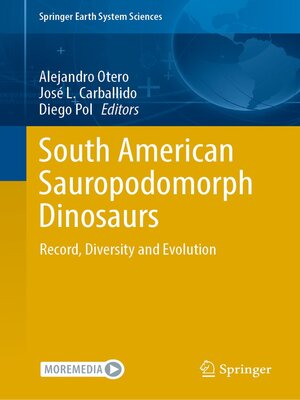South American Sauropodomorph Dinosaurs
ebook ∣ Record, Diversity and Evolution · Springer Earth System Sciences
By Alejandro Otero

Sign up to save your library
With an OverDrive account, you can save your favorite libraries for at-a-glance information about availability. Find out more about OverDrive accounts.
Find this title in Libby, the library reading app by OverDrive.



Search for a digital library with this title
Title found at these libraries:
| Library Name | Distance |
|---|---|
| Loading... |
Sauropodomorpha Huene 1932 is one of the most successful groups of dinosaurs, including the most abundant and diverse herbivorous forms with a worldwide record, extending from the late Triassic to the late Cretaceous. Sauropodomorphs comprise a diverse assemblage of early forms (traditionally called "prosauropods") and the well-established clade Sauropoda Marsh 1878. Early sauropodomorphs were small to medium sized forms, with long necks and reduced skulls, mostly bipeds and omnivores and were abundant in continental environments in the Late Triassic and Early Jurassic. With more than 150 valid species and a worldwide distribution, Sauropoda includes the dominant herbivorous dinosaurs, from the Middle Jurassic to the Late Cretaceous. Its unique body plan, characterized by gigantic size, graviportal locomotion, long necks and tails, and reduced skulls, made this group an undisputed icon in popular culture since the 19th century. In South America, the sauropodomorph record isparticularly rich and abundant, and many species have shed light to understand important milestones in the evolutionary history of this group of dinosaurs. The origin of Sauropodomorpha, the transition to Sauropoda, and the diversification of its most successful evolutionary lineages are largely exemplified by the South American fossil record. In this contribution, we synthetize the diversity of sauropodomorphs from South America, including data on their geographic and stratigraphic provenance, phylogenetics, paleobiology, taphonomy and behaviour, underscoring their significance within the context of sauropodomorph evolution.







